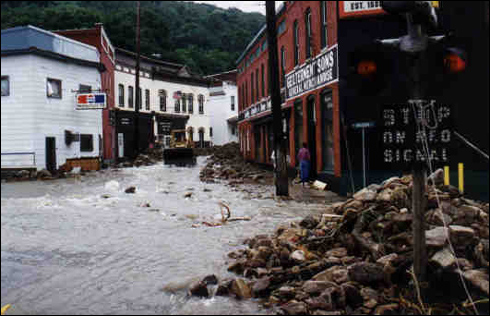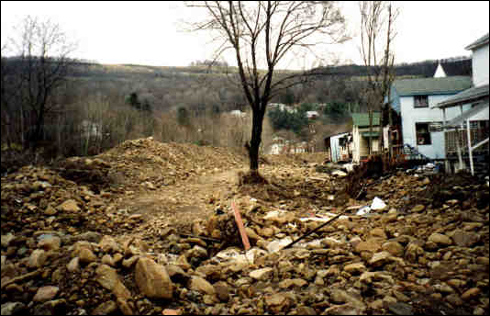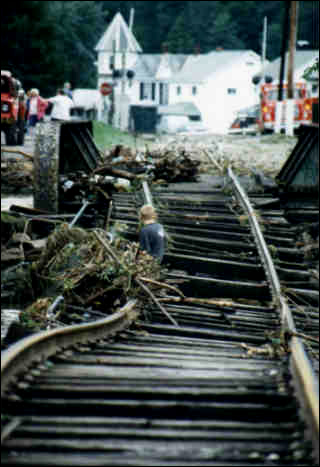Maryland Flood
Flooding in Maryland is caused by both heavy rains and wind. In the upland areas, storms can cause streams and rivers to overflow their banks, inundating the surrounding floodplains. Along the tidal reaches of the Atlantic and Chesapeake Bay coastline, wind driven waves on top of elevated tidal levels can severely damage coastal property and endanger lives of residents.
Intense rainfall associated with hurricanes, such as Agnes (1972) and Fran (1996), has caused widespread damage along the State's rivers and streams. Coastal storms, such as the 1933 hurricane that opened the inlet at Ocean City, primarily affect the Atlantic Coast. In 2003, tidal surges from Isabel caused widespread flooding throughout the Chesapeake Bay and its tributaries which were close to the 100-year flood.
 |
| Floodwaters penetrated some businesses on Jackson Street in Lonaconing, MD. |

Floodplains
Floodplains are low-lying areas adjacent to streams and rivers. These areas naturally absorb the energy of floodwaters and reduce the damage to the river channel. Floodplains are also areas where excess sediment and debris associated with floods are deposited by the river after a storm. Floodplains are mapped by the Federal Emergency Management Agency (FEMA) for the National Flood Insurance Program (NFIP). The 100-year or 1% chance flood is mapped and used for regulatory purposes.
 |
| After the water subsided, much rubble was left behind. (Main St. West, Lonaconing, MD) |
"Size" or Significance of Storms and Hurricanes
Rain, wind and snow storms of all sizes, can cause flooding, depending on the amount of precipitation and its intensity and/or the speed and direction of the wind. Summer thunderstorms are generally very intense but short duration events, which can cause flooding of major rivers. Hurricanes and "northeasters" typically bring the sustained winds and rain necessary to cause significant flooding in large rivers and coastal areas.
The size of the storm based on its duration and intensity is typically measured in terms of the average frequency that a storm of that size occurs. Hurricane Fran was classified as a "40 year storm" meaning that on average storms the size of Fran only occur once in 40 years. This is not to say that a storm the size of Fran couldn't occur next year. A more accurate way of stating storm size is its probability of occurrence. A storm the size of Fran has a one in forty chance of occurring in any given year. Larger storms such as Hurricane Agnes, have a 1 in 100 chance of occurring in a year. Isabel was considered to be a 75-80 year storm based on the tidal surge. In a few places, the rainfall from Floyd was 20 inches and exceeded the 500-year storm.
Land Use and Runoff
The type of land use in an area also affects the nature of floods. In totally forested areas, rainfall is readily absorbed into the ground and flows slowly into streams through groundwater pathways. The presence of snow cover or frozen ground can worsen flood conditions because rainwater does not soak slowly into the ground. Likewise, roadways, parking lots and rooftops in developed areas shed water quickly and channel it directly into streams, resulting in more damaging floods.

Protection Programs
Flood protection efforts directed at the prevention of loss of life or property are oriented toward 100 year storms and storms of lesser magnitude. Maps of those areas that are inundated by the 100-year storm are used to establish special regulatory control areas (see map below). The extent of these areas varies along free flowing rivers depending upon the contours of the land and the presence of obstructions (dams and bridges). In tidal areas, elevations above mean high tide between 5 and 9 feet generally mark the extent of 100-year events.
Flood Relief Assistance
Assistance in dealing with the damage associated with flooding comes in two forms: 1) disaster relief, and 2) mitigation (removal of the threats).
1) The Federal Emergency Management Agency (FEMA), may provide emergency financial assistance to individuals and communities following a flood if the damage threshold defining a federal disaster is exceeded in the area, or if federal flood insurance is in force. Flood insurance is offered by FEMA through participating commercial agents. For uninsured persons, the amount of the relief for first time flood event is reduced by the amount of the premium that would have been required to insure the building and its contents. Relief for second and subsequent events may not be provided unless insurance has been purchased.
Maryland has 116 communities which participate in the National Flood Insurance Program (NFIP). By joining the NFIP, communities agree to establish restrictive ordinances in their 100-year floodplains, which makes federal flood insurance available to all residents. More than 54,000 policies are in force in Maryland with a total property insurance value of $7 billion.
 |
| Rushing floodwaters had such force that they uprooted and twisted these train tracks rendering them useless. |
MDE provides technical assistance and training to local communities to assist in establishing and maintaining eligibility in the NFIP.
2) Once a flood has occurred, there are two programs that can provide financial assistance in preventing future damage.
FEMA's Hazard Mitigation Grant Program (HMGP) provides states with an amount equal to 7.5% of the emergency financial assistance rendered immediately following the declared disaster. HMGP funds are matched with State and local funds on a 75/25 basis. Projects such as property purchases, house relocations, or house elevations are undertaken to reduce the risk of future damage to those properties within the 100-year floodplain.
Under the State's Comprehensive Flood Management Grant Program (CFMGP), established in 1976 following hurricanes Agnes and Eloise, the Legislature authorized MDE to request the sale of bonds to generate funds to purchase, relocate and elevate houses. The program can also be used to establish warning systems and build flood control structures. State funds provided by this program are matched on a 50/50 basis with those from local governments.
FOR MORE INFORMATION CONTACT:
Maryland Department of the Environment
Water and Science Administration
1800 Washington Blvd.
Baltimore, MD 21230
410-537-3000